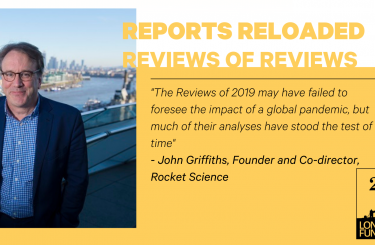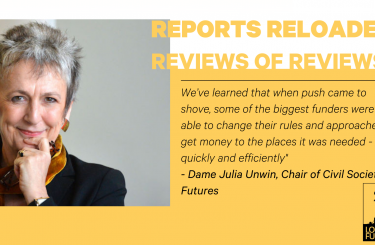Related



For our third piece in the Reports Reloaded series, Paul Roberts, CEO of the LGBT Consortium reflects on the Government’s Civil Society Strategy, published in 2018 and look at what is needed to build a future that works for everyone – a central focus of the Government's strategy.
Buildings need careful design, construction and maintenance—not just thrown up. A good, solid structure enables strong foundations and the ability to withstand everything that is thrown at it. A building constructed with speed can lack quality, inevitably leading to cracks showing quickly with more serious interventions needed when those cracks are simply covered up.
A strange way maybe to start a blog about reflections on the Government’s 2018 'Civil Society Strategy: Building a future that works for everyone’ - but is always something I think about (maybe because I am also an avid house renovator!) when reflecting on how we tackle the golden egg of supporting communities where they can truly become sustainable, resilient and well resourced. This was something the Ministers themselves touched on in their foreword to the Strategy, talking about it being something “to help government strengthen the organisations, large and small, which hold our society together” and how “civil society is central to this new approach”.
How can we support sustainable and resilient organisations as funders unless we think cleverly about how we support them?
We need to invest and not just fund. How can we support sustainable and resilient organisations as funders unless we think cleverly about how we support them? I have no issue with project funding where organisations have specific needs and wants, but we have a duty to think about how we best co-produce investments which don’t set a default where organisations have to fit their need for proper investment into a project box for a limited time.
Community organisations know what they need—they are after all rooted in their own communities, bring a lived experience which should never be taken for granted, and the diversity of those communities tackling deep rooted inequalities is simply inspiring. I have quickly come to realise that the more established my organisation – the LGBT Consortium- becomes as a specialist grant funder, that it isn’t all about the money (obviously that is very, very helpful!). Investing goes beyond just funding. It is the connections we as funders can help make, it is the additional wraparound support that infrastructure bodies and others can provide and it is being involved in the design, decision-making and reflecting on those investments. That is where it gets super exciting and system-changing can start to emerge.
Whilst much of the Civil Society Strategy, well indeed everything, has been torpedoed by the pandemic, now is actually the ideal opportunity to bring back its core elements and push for the diversity of our communities to be the central pillar in those conversations. Now is the ideal time to push the boundaries of what systems change could look like. After all, interventions like the London Community Response have shown what collaboration across bodies can achieve! Back in 2018, the Civil Society Strategy talked about the foundations of social value and the interconnectivity of sectors. If the pandemic has taught us anything, let’s not just talk, let’s do. Now is the time.
The Civil Society Strategy, whilst of its time, still has relevance. We just need to take a few risks, try out new and exciting materials, trust in our communities, and collaborate with the diversity of communities
The Strategy talked about “enabling a lifetime of contribution”. I love this concept—we should all be in this for the long term. Programmes like the Youth Endowment Fund (part of the government’s long term plan to tackle serious violence) should become the norm with long-term thinking which goes beyond political locked timelines.
I am eternally grateful to the Government Equalities Office for having invested in LGBT+ communities through Consortium’s LGBT+ Futures grants programme. This was an action in the Westminster Government’s LGBT Action Plan. It had the potential to be transformative, not only in the distribution of money, but to change the dynamic between Government and the LGBT+ sector. Sadly though, it became another short-term engagement, which in part has led to the loss of trust and confidence in our ability to develop critical long-term relationships with those in power.
But I don’t say this to be all doom and gloom. There is another way forward. As those in my team will attest to, I am an eternal optimist and always looking for the positive opportunity amongst the negative and I am hopeful that as (or maybe when) we can recover from the pandemic that we see it is as a reset moment where civil society, as the Strategy outlined, truly is regarded as critical. Civil society must be invested in and not just periodically funded.
Of course, we all have our part to play in achieving this. We might not always agree with each other or speak the same language, but we can find common ground and we can find the compromise in the middle where that transformative action has the potential to emerge.
Investing, not funding…maybe then we can see transformative action and build strong well-constructed buildings, to circle back on my opening analogy. The Civil Society Strategy, whilst of its time, still has relevance. We just need to take a few risks, try out new and exciting materials, trust in our communities, and collaborate with the diversity of communities that makes our society so incredibly exciting.
The future that works for everyone—I genuinely believe it is possible.


